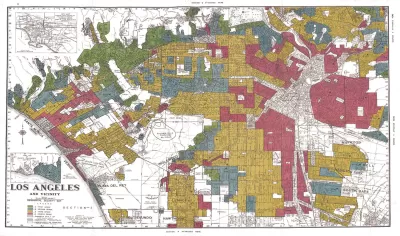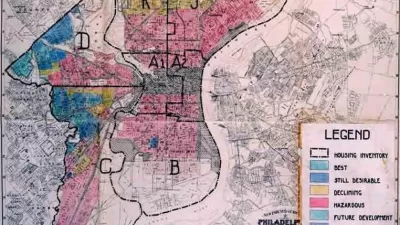President and CEO of the Lincoln Institute of Land Policy Dr. George McCarthy traces the legacy of racist policy and offers guidance toward an economic recovery that begins to undo systemic racism.

In a recent article detailing the historical relationship between racism and land policies, Dr. George McCarthy, president and CEO of the Lincoln Institute of Land Policy, describes the legacy of color-coded redlining maps created during the Great Depression. These secret documents spun up by the Home Owners' Loan Corporation (HOLC) delineated the segregation of opportunity in lending decisions where "neighborhoods that were home to high proportions of people of color or Eastern or Southern European immigrants were always shaded red, regardless of the quality of the homes or the local economy," according to McCarthy. The implication of the red shading was a lack of access to government-backed loans, and in turn, the loss of opportunity for homeownership in the redlined communities.
McCarthy says that the HOLC's maps "deepened the racial and economic divides that have been the subject of recent demonstrations in our cities and those of other countries," and presaged the destruction of Black neighborhoods by the U.S. interstate highway system and urban renewal.
As the United States and the world reckon with another economic depression, economic recovery must rectify the systemic racism made possible by unjust, discriminatory land policy, writes McCarthy. "We cannot make the same mistakes we made in the 1930s—allowing the urgency of the moment to give cover to policies that maintain racial discrimination—nor can we take actions like we did in the Great Recession, prioritizing the wealth and survival of corporations over some communities."
FULL STORY: President's Message: Think Land Policy Is Unrelated to Racial Injustice? Think Again.

Alabama: Trump Terminates Settlements for Black Communities Harmed By Raw Sewage
Trump deemed the landmark civil rights agreement “illegal DEI and environmental justice policy.”

Planetizen Federal Action Tracker
A weekly monitor of how Trump’s orders and actions are impacting planners and planning in America.

The 120 Year Old Tiny Home Villages That Sheltered San Francisco’s Earthquake Refugees
More than a century ago, San Francisco mobilized to house thousands of residents displaced by the 1906 earthquake. Could their strategy offer a model for the present?

Ken Jennings Launches Transit Web Series
The Jeopardy champ wants you to ride public transit.

BLM To Rescind Public Lands Rule
The change will downgrade conservation, once again putting federal land at risk for mining and other extractive uses.

Indy Neighborhood Group Builds Temporary Multi-Use Path
Community members, aided in part by funding from the city, repurposed a vehicle lane to create a protected bike and pedestrian path for the summer season.
Urban Design for Planners 1: Software Tools
This six-course series explores essential urban design concepts using open source software and equips planners with the tools they need to participate fully in the urban design process.
Planning for Universal Design
Learn the tools for implementing Universal Design in planning regulations.
Clanton & Associates, Inc.
Jessamine County Fiscal Court
Institute for Housing and Urban Development Studies (IHS)
City of Grandview
Harvard GSD Executive Education
Toledo-Lucas County Plan Commissions
Salt Lake City
NYU Wagner Graduate School of Public Service





























